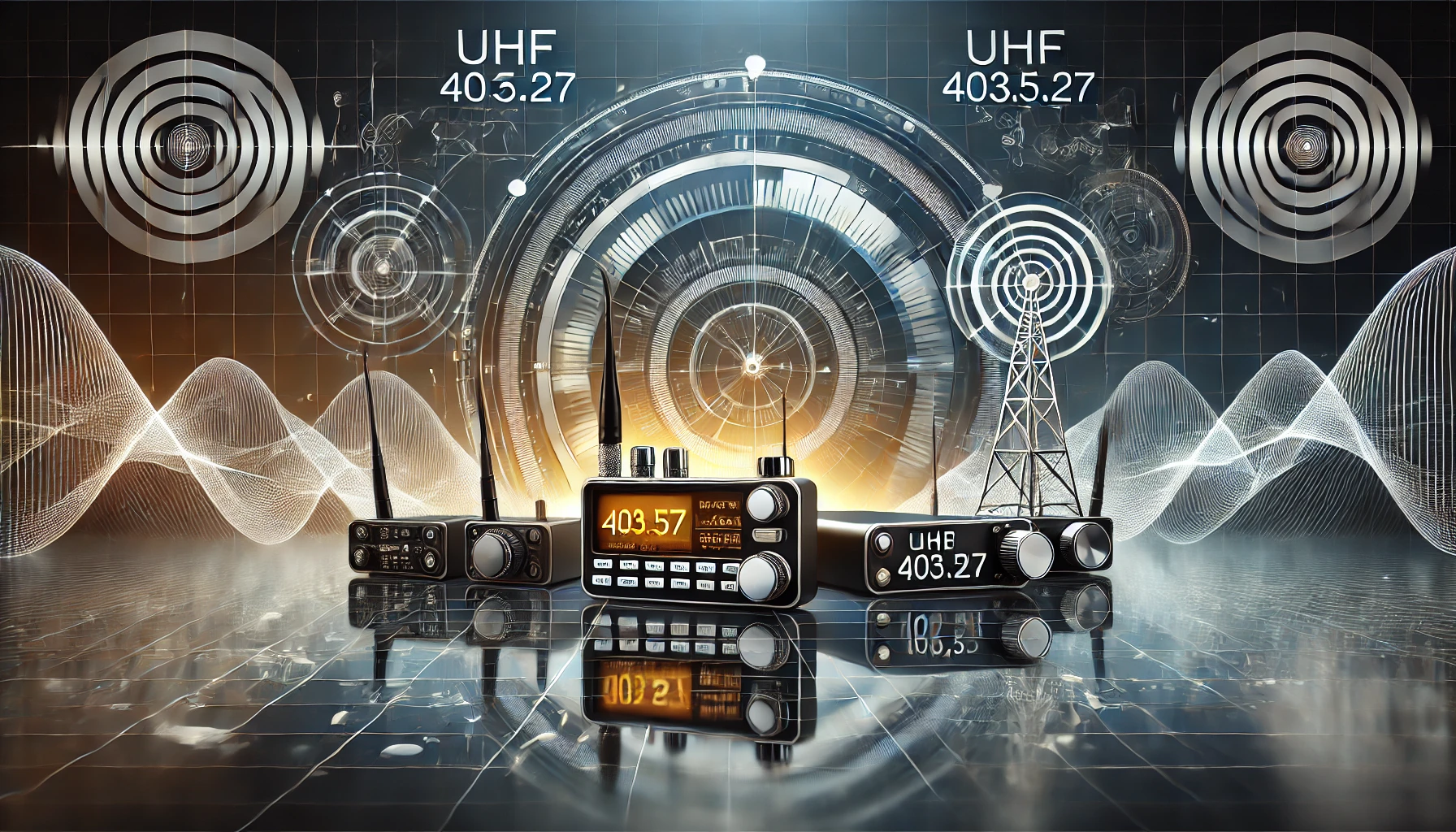In today’s fast-paced world of wireless communication, the UHF 403.527 channel plays a crucial role in keeping industries, public services, and even everyday operations connected. This frequency, which falls under the Ultra High Frequency (UHF) spectrum, is widely used in a variety of applications, from public safety to industrial telemetry. In this guide, we will explore the significance, applications, and future developments of the UHF 403.527 channel, while also examining how it fits into the broader context of UHF frequencies.
1. Introduction to UHF Frequencies
Ultra High Frequency (UHF) refers to the range of radio frequencies between 300 MHz and 3 GHz. These frequencies are used in a variety of communication systems, including television broadcasting, mobile phones, GPS, and Wi-Fi. UHF signals are particularly valued for their ability to penetrate buildings and provide high data transmission rates.
Within this spectrum, the UHF 403.527 channel stands out as a critical frequency for modern communication, offering reliable performance across multiple industries. Whether you are dealing with public safety communications or industrial operations, the UHF 403.527 channel provides a versatile and dependable solution.
2. What is the UHF 403.527 Channel?
The UHF 403.527 channel is a specific frequency that operates at 403.527 MHz. It is primarily used in land mobile radio systems, telemetry, and industrial communications. What sets this frequency apart is its balance between range, data transmission capability, and its ability to penetrate buildings—making it ideal for short to medium-range communication.
In this section, we’ll dive into the key characteristics of the UHF 403.527 channel and why it is preferred for various applications.
3. Key Characteristics of UHF 403.527 MHz
Understanding the technical aspects of the UHF 403.527 channel is essential for leveraging its full potential. Below are some key characteristics that define its performance:
- Frequency: 403.527 MHz, placing it in the lower part of the UHF spectrum.
- Wavelength: Approximately 0.74 meters, making it suitable for short-range communications.
- Propagation: UHF signals typically travel by line of sight but can penetrate buildings and other obstacles to some extent.
These characteristics make the UHF 403.527 channel ideal for environments where reliable communication is crucial, such as public safety and industrial operations.
4. How the UHF 403.527 Channel Powers Communication in Various Industries
The UHF 403.527 channel is used in a wide range of industries, each benefiting from its reliability and versatility. Below are some of the major sectors where this frequency plays a pivotal role:
Public Safety and Emergency Services
Public safety organizations such as police, fire departments, and emergency medical services depend heavily on the UHF 403.527 channel for reliable, mission-critical communications. The ability to maintain clear communication in urban environments, where buildings and other obstacles are prevalent, makes this frequency a top choice.
Industrial and Commercial Use
Many businesses, particularly in manufacturing and logistics, rely on the UHF 403.527 channel for internal communications. Whether it’s coordinating operations in a warehouse or facilitating communication across construction sites, this frequency ensures that operations run smoothly without signal interruptions.
Medical Applications and Scientific Research
In the medical field, the UHF 403.527 channel is used in wireless telemetry systems to monitor patient vital signs in hospitals. It also supports scientific research, where reliable communication between laboratory equipment and central systems is critical for data collection and analysis.
5. Security and Privacy in UHF Communications
Given its widespread use in critical sectors, security is a major concern when using the UHF 403.527 channel. Public safety organizations, industrial operators, and even medical facilities must ensure that their communications are protected from unauthorized access and interference. Encryption technologies are often used to secure transmissions over UHF frequencies, ensuring that sensitive information remains private.
Moreover, regulatory bodies such as the Federal Communications Commission (FCC) in the United States and the European Telecommunications Standards Institute (ETSI) in Europe provide guidelines to minimize interference and maintain secure communication channels.
6. Challenges in Using UHF for IoT Systems
The Internet of Things (IoT) is revolutionizing industries by connecting devices over vast networks. However, the integration of IoT systems with the UHF 403.527 channel presents some challenges. One of the primary challenges is ensuring that the frequency can support the vast number of connected devices without interference. Although UHF frequencies are well-suited for IoT applications due to their ability to transmit over long distances with low power consumption, careful planning is needed to manage bandwidth and avoid signal congestion.
Additionally, as more IoT devices rely on UHF frequencies, maintaining security and ensuring compliance with regulations becomes even more critical.
7. Comparison of UHF 403.527 with Other UHF Frequencies
To better understand the importance of the UHF 403.527 channel, it’s helpful to compare it with other nearby UHF frequencies. Below is a comparison chart of UHF frequencies and their common uses:
| Frequency (MHz) | Common Uses | Relative Advantages |
| 400.150 – 406.000 | Meteorological aids, space research | Less crowded, good for specific applications |
| 406.100 – 410.000 | Fixed and mobile services | Similar characteristics to UHF 403.527 MHz |
| 410.000 – 420.000 | Fixed and mobile services, space research | Slightly better building penetration |
| 420.000 – 450.000 | Amateur radio, radiolocation | More bandwidth available for amateur use |
The UHF 403.527 channel offers a balance between signal penetration, bandwidth, and range, making it particularly suitable for land mobile radio systems, industrial applications, and public safety communications.
8. Global Regulations and Licensing for UHF 403.527 MHz
The use of the UHF 403.527 channel is regulated by different governmental bodies around the world. In the United States, the Federal Communications Commission (FCC) oversees the allocation and licensing of this frequency. In Europe, the European Telecommunications Standards Institute (ETSI) handles similar regulatory duties.
It is important for businesses and organizations to obtain the necessary licenses before operating on the UHF 403.527 channel to avoid legal issues and ensure compliance with local regulations. Licensing helps prevent interference with other communication systems and ensures the smooth operation of critical services.
9. Technological Innovations for UHF Frequencies
As communication technologies evolve, so do the applications and capabilities of UHF frequencies, including the UHF 403.527 channel. Below are some technological innovations shaping the future of UHF communication:
Digital Migration
Many systems that use UHF frequencies are transitioning from analog to digital technology. This shift offers numerous benefits, such as improved voice quality, encryption options, and more efficient spectrum usage. Digital systems also allow for the transmission of data alongside voice communications, making them ideal for modern industries.
Software-Defined Radio (SDR)
SDR technology enables radios to adapt to various frequencies and communication protocols on the fly. This flexibility makes SDR a valuable tool for optimizing the use of UHF frequencies, including the UHF 403.527 channel. As SDR technology advances, it is likely to play a larger role in public safety and industrial communication systems.
10. Best Practices for Using UHF 403.527 MHz in Modern Applications
To maximize the benefits of the UHF 403.527 channel, it’s important to follow best practices. Here are a few recommendations for ensuring optimal performance:
- Obtain the Proper Licensing: Make sure your organization has the necessary licenses to operate on this frequency.
- Use Suitable Antennas: A quarter-wave antenna for the UHF 403.527 channel would be about 18.6 cm long, which is ideal for maintaining strong signal transmission.
- Minimize Interference: Be aware of potential sources of interference and use filters or shielding to protect your communications.
- Regular Maintenance: Keep your communication equipment well-maintained to ensure reliable performance over time.
11. FAQs about UHF 403.527 Channel
Here are some frequently asked questions about the UHF 403.527 channel:
- What is the typical range of the UHF 403.527 channel?
- The range depends on the environment, but it typically works best for short to medium-range communications, especially in urban areas.
- Do I need a license to use the UHF 403.527 channel?
- Yes, licensing is usually required in most countries to operate on this frequency, especially for commercial or public safety use.
- Can the UHF 403.527 channel be used for IoT applications?
- Yes, the channel is suitable for IoT systems, although bandwidth management and interference mitigation are crucial.
12. Conclusion
The UHF 403.527 channel is a vital frequency for modern communication, offering reliable performance across industries such as public safety, industrial operations, and medical research. By understanding its key characteristics, applications, and the challenges it faces in the evolving landscape of wireless communication, businesses and organizations can fully leverage its benefits. As technology continues to advance, the UHF 403.527 channel will remain a critical component of communication systems, ensuring that the world stays connected.
By following best practices and staying up-to-date with technological developments, you can ensure that your use of the UHF 403.527 channel is optimized for the future.


